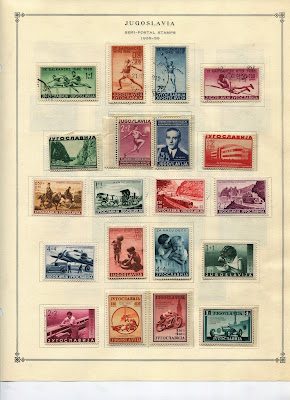King Alexander I of Yugoslavia
Bud's Big BlueBud's Observations
I think King
Alexander looks rather like Peter Sellers, the comic actor of Pink Panther fame.
But there is nothing comedic about the king. Alexander, known as the Unifier, tried
to fuse six Balkan nations following World War I. Herding panthers would have
been easier, and less deadly. People living in Serbia, Croatia, Bosnia and
Herzegovina, Macedonia, Slovenia, and Montenegro lacked common goals, ethnicity,
religion, language and even alphabet. (See, for illustrations, BB’s pre 1920 Yugoslavia
selections, also BB’s stamps for Montenegro, Serbia and Bosnia.)
Nevertheless
in 1918, Alexander, then prince regent, helped cobble together the Kingdom of Serbs, Croats and Slovenes -- an
internationally welcomed development since events in this region had sparked WWI.
Upon the death of his father in 1922, Alexander became king. In 1929 he renamed
the Kingdom as Yugoslavia, following popular usage.
Leaving
no diary or memoire, Alexander remains a sketchy historical figure. He did,
however, leave many paintings and photos of himself. Until his death, almost all
Yugoslav stamps have his image affixed. (Note that the 1969 BB edition omits
some of these that earlier editions included). Perhaps publishing his face was
a unification strategy aimed to boost solidarity, even as he became less
popular.
Turbulence
filled Yugoslavia’s 1930s; the Croatians were especially unhappy. At one point,
Alexander declared that anyone who wanted a regime change in Yugoslavia would
need “to kill me.” On Tuesday, 9 October 1934, a Croat-sympathizing Bulgarian
obliged. Yugoslavia’s 1934 stamps issued with Alexander’s image encased in
black borders are striking, and sad. But the assassination precipitated no
regime change; Alexander’s son, Peter II, became the boy king featured in the
1935 stamp series.
I like
Alexander, a quiet man of military demeanor who sought unity in the midst of
diversity and who wanted land reforms favorable to peasants.
Jugoslavia (as it is still spelled in Big Blue), or Yugoslavia (as it is more commonly known), or the Kingdom of Serbs, Croats and Slovenes ( the official name from 1918-1929), was a diverse country of Slavic peoples that existed from 1918-1992. More specifically, the Kingdom of Yugoslavia formed between 1918-1943, the period of interest to this blog.
It was born after WW I when a general movement of pan-Slavic nationalism was on the ascendancy, and with the collapse of the Austro-Hungarian Empire.
The Kingdom was able to come together, because 3/4 of the population spoke an intelligible variant ( to each other) of Serbo-Croatian.
Although they shared a language, albeit with different dialects, the Croats and Serbians did not share much else. And hence the conflicts that would explode later.
Original Blog Posts & BB Checklists
Jugoslavia 1918-1920
Jugoslavia 1921-1940
Page 1
1a
1b
1c
Page 2
2a
2b
2c
2d
Page 3
3a
3b
3c
Page 4
4a
4b
4c
Page 5
5a
5b
5c
Page 6
6a
6b
6c
Page 7
7a
7b
Page 8
8a
8b
Page 9
9a
9b
9c
Page 10
10a
10b
10c
Page 11
11a
11b
11c
Page 12
12a
12b
12c
Page 13
13a
13b
Page 14
14a
14b
14c
Supplements
Page 1
Page 2
Page 3
Page 4
Page 5
Note: Pic of Alexander I and Peter Sellers are used here for educational purposes.
Comments appreciated!





























































No comments:
Post a Comment